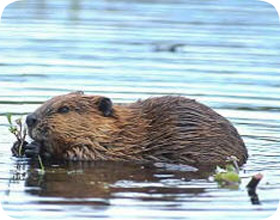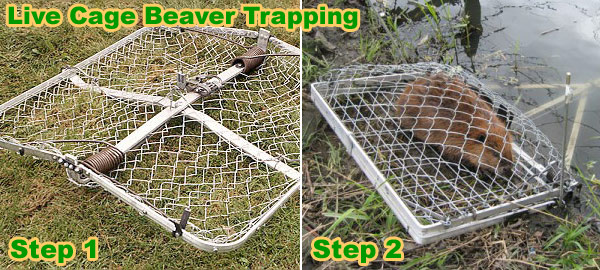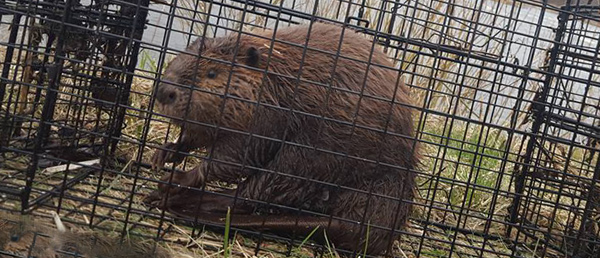- info@wildlife-removal.com
Call us for help in your town
Wildlife Removal Education
How To Get Rid of Beavers
Need beaver removal in your hometown? We service over 500 USA locations! Click here to hire us in your town and check prices - updated for year 2020.
 Beavers are usually classified as a pest species due to their habits of building dams. The most common complaints include the following:
Beavers are usually classified as a pest species due to their habits of building dams. The most common complaints include the following:
- Area flooded due to beaver dam
- Creek destroyed by beaver activity
- Trees destroyed by beaver activity
How To Get Rid Of Beavers In A Pond, Lake, or River
Of all the animals you can try to trap or remove you will find that beavers are some of the most challenging. They can get to places that are hard for a human to get to. They are also perfectly at home in water and although they are the biggest rodents, they can move through debris with ease. Unfortunately, they must be removed when they are close to homes because they can leave a trail of destruction if not taken care of in time.
If you live close to a river or pond, they can cause a flood by creating their famous beaver dams. They can also damage surrounding vegetation and in some cases they have been known to knock down trees. Now imagine having a home close to a fallen tree and you will know why getting rid of beavers is important. Unfortunately, getting to the beavers when they’re in the water is extremely challenging. Most repellents that you find aren’t your wisest choice. You will do best to trap the beaver and remove it to an unpopulated area that would be a good habitat for them.

How To Get Rid Of Beavers In A Beaver Dam
A beaver dam is the beaver’s bread and butter. It uses it for hunting and as a home. The beaver dams are also the main cause of damage to property by causing floods. Because of all the debris around the beaver dam, it will be difficult for a human to get there. The best solution is to place traps in the area surrounding the dam. You can use fresh fruit as an incentive inside the trap or jelly or peanut butter. Because there is no guarantee that a beaver will see the trap or smell its contents, you should try to place more than one trap in the area.
Make sure to also cover the trap with vegetation from the area because beavers are actually pretty smart animals. If they sense that there is a trap or they see a trap go off, they will stay away from the area altogether. Another reason to use more than one trap is that if you have one beaver, then chances are that you have a few more. Traps are the most effective way of catching beavers, but you have to make sure that you actually catch all of them because beavers can actually reproduce pretty fast.
We now service over 500 locations! Click here to hire us for wildlife removal in your town.
How To Get Rid Of Beavers In Your Woods
If the beavers are not in a dam, but are instead in the woods, you should thank your lucky stars because your life just got a lot simpler. You will still set up the traps and you should set them close to a body of water. Use the same kind of bait and with a little luck you will have trapped the beavers in less than 24 hours. You should know that the reason you are placing the traps near the water is because beavers need to be close to the water so it is more likely that they will be trapped there.
You can find these traps at some home and gardening stores everywhere as well as some outdoor and hunting stores. Keep in mind that beavers are the biggest rodents in the US so you should get a trap big enough for them. Another thing you can do to get rid of beavers in the woods is to mix latex paint with fine sand and use the mixture on the base of trees. That will work to repel the beavers.
How To Get Rid Of Beavers In Your Yard
Beavers will not usually be found in people’s yards. They try to stay away from humans because they see us as predators. But in those rare cases where you do have beavers in your yard, there are easy ways to keep them out. You can use the same mixture of paint and sand on your trees to keep the beavers away. If you do not like the way the paint makes your trees look, then you can use wire fence around your trees.
Make sure that this fencing is at least four feet tall from the ground. Once you are certain that there are no beavers in your yard, you can keep them out with a fence of the same height. Because some beavers will also dig, it is recommended that you use an underground fence which should be made of metal and not plastic to prevent the beaver from simply digging through it. A lot of people will want to kill the beavers, but you should know that it’s not always legal to do so. And if you follow these instructions, you should be able to get rid of them humanely.
Read more about Beaver Removal. Some beaver trapping methods call for lethal control. To learn more about this, read my How To Kill a Beaver page.
How to Get Rid of Beavers - Beavers are highly industrious and in some environments, their activities tend to be destructive. Their tree cutting and dam building habits for instance have been known to result in flooded farm fields. Most homeowners as well do not like to have their trees hewn down at will by these rodents. The semi-aquatic beavers are very adept at adapting and this makes it difficult to control them. Other complaints include home flooding, flooding of highways or railroads, blockage of drainage systems and contamination of water supplies.

To control beavers effectively, you must first identify their location and the type of damage being caused by their activities. You may then select the best method to employ, and the best way to approach it.
Live Trapping
While selecting the live trap to use for beavers, go for the extra-large and durably strong such that the trap is able to support the size and weight of a beaver. A galvanized 12 gauge wire cage would do. The trap should be positioned near the home of beavers. Beaver trapping requires a lot of patience as the large rodents are known to be trap shy.
- Determine their travel path, which is usually defined, and find a level spot for the trap along it.
- Bait the trap with beaver castor if available, or use polar twigs in the alternative.
- Set the trap before dusk when the nocturnal beavers would emerge and face it towards their pond home.
- Check the trap often to prevent any beaver caught from suffering long.
- Once you have a catch, wear protective rubber gloves before handling the cage to avoid any contact with the animal.
- Transport your beaver with care to another water body at least 10 miles away from your place and release it there. You may want to get help with lifting the beaver as they can weigh as much as 50 pounds.
Exclusion
This is not so easy with beavers because they are particularly skilled at changing the environment to suit them. Beaver exclusion is mostly done after beavers have been removed from a property. Before carrying out this habitat modification, you must ensure that all beavers have been removed from the dams and lodges.
- Destroy all dam structures as well as the lodges. Beavers have been known to rebuild dams quite dexterously, so you must be consistent with dismantling them until they are all gone. Destroy the building materials as well with a wood chipper to make rebuilding more difficult for them.
- Install tree guards around all your trees, which constitute the source of building materials for beavers. Wrap the trees in 2 to 3 inches wire mesh or hardware cloth. The tree wraps should be fastened to the ground and the trees so beavers don’t chew them off. They should also be at least 3 feet tall, to be effective.
- Construct a wire mesh fence: The wire mesh should be made of metal rods and chain link. For maximum effectiveness, this fence must be 3 feet to 4 feet high. It must also be buried at least 18 inches or one foot into the ground. The bottom of the fence should be made of stakes and the stakes put within the frame of the mesh fence because the beavers are so smart that they can dig deep into the ground and lift up the fence. Ensure to check and re-check your fence regularly to ascertain that everything is still in their proper place. A weekly check is highly recommended in the least.
- Sand and Paint – this is an economical way to prevent beaver damage and infestation. Get some latex paint from your local store and mix with sand in equal proportions. Paint all the trees in your yard of farm up to 4 feet in height. A major disadvantage of this method is that you have to rinse and repeat daily which is no small feat.
- Build a drainage system over the beavers’ dam. This will allow proper channeling of water to the appropriate channels and disallow the animals to control water flow.


















